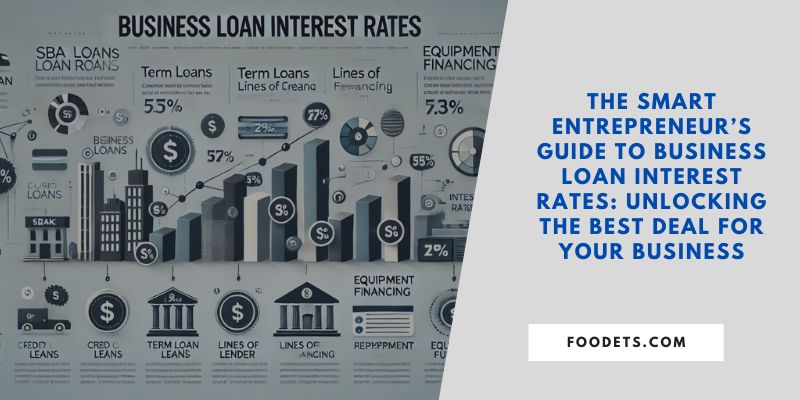Introduction: The Costly Mistake I Almost Made
Years ago, when I was first expanding my business, I walked into my bank with excitement, ready to take out a loan. The loan officer smiled, shuffled some papers, and handed me a contract. I skimmed it, saw the interest rate, and figured it was “standard.” I signed.
Big mistake.
A year later, I realized I had agreed to a loan with a rate much higher than necessary. Worse, I didn’t pay attention to the fine print, which included hidden fees and a prepayment penalty. If I had done my research, I could have saved thousands of dollars. That’s why I’m writing this—so you don’t make the same mistake.
Understanding business loan interest rates is crucial. Whether you’re launching a startup or scaling your operations, knowing how these rates are determined and how to secure the best one can save you money and stress. So, let’s dive in.

How Business Loan Interest Rates Are Determined
Lenders don’t just pull interest rates out of thin air. Several factors determine the rate you’ll get:
1. Your Credit Score (Both Personal & Business)
Lenders look at both your personal and business credit scores. If you’re a new business without a credit history, they’ll rely more on your personal credit. The higher your credit score, the lower your interest rate. A score above 700? Great. Below 600? Expect to pay more.
2. Loan Type
Different loan types have different risk levels for lenders. A well-secured SBA loan will have lower rates than a high-risk short-term loan.
3. Lender Type
Banks typically offer lower rates than online lenders, while credit unions and alternative lenders fall somewhere in between.
4. Repayment Term
Shorter-term loans often have higher interest rates because lenders want their money back quickly. Longer-term loans usually have lower rates, but you may pay more interest over time.
5. Economic Conditions
Interest rates fluctuate based on economic conditions. When the Federal Reserve raises rates, business loan rates follow.
How to Secure the Lowest Interest Rate
1. Improve Your Credit Score
- Pay off debts and avoid late payments.
- Regularly check your credit report for errors.
- Build business credit by using a business credit card responsibly.
2. Shop Around
Never accept the first offer. Compare rates from multiple lenders—banks, credit unions, online lenders, and SBA-backed loans.
3. Negotiate the Terms
Everything is negotiable. If you have strong credit, ask for a lower rate or better terms.
4. Offer Collateral
Secured loans (where you offer assets like real estate or equipment) often come with lower interest rates.
5. Strengthen Your Business Financials
Lenders want to see a healthy cash flow. Show them strong revenue, a solid business plan, and stable finances.
Business Loan Types and Their Interest Rates
Here’s a quick comparison of common business loans and their typical interest rates:
| Loan Type | Typical Interest Rate Range |
|---|---|
| SBA Loans | 5% – 10% |
| Term Loans (Bank) | 4% – 12% |
| Term Loans (Online) | 7% – 30% |
| Business Line of Credit | 7% – 25% |
| Equipment Financing | 6% – 20% |
| Invoice Factoring | 10% – 60% |
| Merchant Cash Advance | 20% – 100%+ |
SBA Loans: The gold standard for low rates, but they require extensive paperwork and strong financials.
Term Loans: Traditional bank loans offer competitive rates but require a good credit score. Online term loans are more accessible but pricier.
Lines of Credit: Good for managing cash flow but can have variable rates.
Equipment Financing: Useful for purchasing machinery with competitive rates.
Invoice Factoring & Merchant Cash Advances: These offer quick cash but at extremely high costs. Avoid if possible.
Common Interest Rate Traps to Avoid
1. Variable Interest Rates Without a Cap
Variable rates can start low but may increase dramatically. If choosing a variable-rate loan, ensure it has a cap.
2. Hidden Fees
Some loans come with origination fees, maintenance fees, and prepayment penalties. Always read the fine print.
3. Predatory Lenders
Be wary of lenders offering “guaranteed approval” or asking for upfront fees. If it sounds too good to be true, it probably is.
Fixed vs. Variable Interest Rates: Which is Best for You?
Fixed Interest Rates: Stay the same throughout the loan term. Best for businesses that want predictable payments.
Variable Interest Rates: Change based on market rates. Best for businesses that can handle some risk in exchange for potential savings.
When to Choose Fixed: If rates are low and you want stability.
When to Choose Variable: If rates are high now but expected to drop.
Final Thoughts: Make Interest Rates Work for You
Interest rates can make or break a business loan deal. Understanding how they work and how to secure the lowest rate will save you money and ensure your business thrives.
Before signing any loan agreement, compare rates, read the fine print, and negotiate. A few percentage points might not seem like much, but over the life of a loan, they can mean thousands of dollars saved—or lost.
The bottom line? Be informed, be strategic, and make lenders compete for your business. That’s how you win in the world of business financing.